Research - (2023) Volume 11, Issue 1
Effect Of Vitamin C On Color Characteristics Of Different Restorative Materials.
Abdulaziz Zahid*, Ayman Alkaabi, Hanan K Abouelseoud and Dalia Abuelmagd
*Correspondence: Abdulaziz Zahid, Department of Restorative Dentistry, Faculty of Dentistry, King Abdulaziz University, Jeddah, KSA, Email:
Abstract
Background/purpose: During pandemic (Covid19) Adults frequently increase vitamin C syrups and effervescent tablets intake for dietary support, The purpose of this study was to see how the different forms of Vitamin C syrup and effervescent tablets affected the color stability of two newly marketing esthetic restorative materials (Filtek bulk fill) resin composite and Resin Modified glass ionomer (Medifil IX forte LC). Materials and methods: A total of 90 disc-shaped specimens, 45 from each restorative material. The specimens were papered and randomly divided into six subgroups according to the immersion media of vitamin C either syrup (HIC Stars (FUTURE HERBALS, Nutra-C, USA),or effervescent tablet (Sanotact, Germany) and distilled water (control group), each contains 15 samples. The samples were immersed in 2 vitamins C for 2 min once a day for 28 days. Color stabilities measurements were recorded at baseline before immersion and on the 28th days after immersion. Color stability was measured using a spectrophotometer. Using CIELAB. ΔE Data was processed using statistical of Kruskal Wallis test and Mann Whitney U test. Results: There was a significant difference in the change of composite color when immersed in the three different solutions (p=0.010). Composite showed significantly less change in color when immersed in effervescent (4.8 ± 1.5) compared to water (6.7 ± 1.5). There was also a significant difference of color change of RMGI when immersed in the different solutions (p<0.001). RMGI immersed in effervescent showed significantly higher mean change in color (4.0 ± 2.6) compared to the mean change in color of RMGI when immersed in syrup (1.1 ± 2.5) or water (0.9 ± 1.1). Conclusion: The usage of different forms of vitamin C syrups and effervescent tablets for 28 days have a negative impact on the color stability of (Filtek bulk fill) resin composite and Resin Modified glass ionomer (Medifil IX forte LC).
Keywords
Covid-19, RMGI
Introduction
Ascorbic acid (vitamin C) is an important water-soluble vitamin found in many fruits and vegetables. It has welldocumented beneficial effects on the human body and is used as a supplement, alone or in combination with other vitamins and minerals. Vitamin C role in our body is important that prevents many diseases by enhancing our immune response. It contributes to the synthesis of collagen and consequently aid in tissue repair, wound healing and formation of blood vessels walls lining.
Vitamin c is called ‘’scavenger of free radicals“ as it is antioxidant water-soluble molecule, means it protects the cells from damage.
Research Question/s: Do different forms of vitamin c have an impact on color characteristics of different restorations?
Research Hypothesis: vitamin c has no effect on color characteristics of both bulkfil resin composite and RMGI.
Research Objectives: to compare the color stability of both bulkfil resin composite and RMGI restorations before and after immersion into vitamin C syrup and effervescent tablet for 28 days.
Significance of the Study: during the pandemic, there has been increased consumption of Vitamin C products because it enhances immune system and this study is needed in such situations.
Impact of the study
A: Social impact: Increase the longevity, durability and Esthetic appearance of both bulkfil resin composite and RMGI restorations.
B: Economic impact: Reduce the need for repairing of esthetic restorations.
Literature review
The world has experienced the global outbreak of the pandemic (Covid19), since its beginning in Wuhan city, China, people started to react to the situations in different manners and many of them has taken vitamin C supplements and other medications to enhance their immune system and to help their body to fight the newly emerging respiratory disease. Our body needs adequate amount of vitamins in general to keep healthy and to stay in good shape. Vitamin C role in our body is important that prevents many diseases by enhancing our immune response. It contributes to the synthesis of collagen and consequently aid in tissue repair, wound healing and formation of blood vessels walls lining. Vitamin c is called ‘’ scavenger of free radicals “as it is antioxidant water-soluble molecule, means it protects the cells from damage [1]. Vitamin C known as (ascorbic acid) is an essential dietary nutrient and water-soluble molecule, it is found naturally in plants such as orange, broccoli and some kinds of fish and birds. Since human body cannot synthesize the vitamin C; we need to take it from the mentioned external sources in our diet [2]. Vitamin C has been popularly enrolled in the prescribed medications for people who have common cold since the past and in many trials as an intervention. recently the prominent role of vitamin C in covid-19 pandemic has proven its ability to fight the infection of SARS-COV-2, HSV-1, EBV,HIV, and other DNA and RNA viruses [3]. According to new recent studies, in USA and China, covid-19 patients have been treated vitamin C and the results were promising. vitamin C prevents cytokines storm which happens during the novel corona virus infection, thus this vitamin is considered antiinflammatory molecule as well as anti-oxidant one. [4]. Vitamin. C can possess anti-thrombotic function and therefore counteract the complication and formation of microthrombi in the infected body with corona virus. Moreover, vitamin C supports the immune systems during infections by improving T-cell function and help the body fight the disease. Antira C carr et al.(2020) revealed that vitamin C reduces the mortality rate and ICU stay [5]. Therefore, deficiency of vitamin C can lead to problematic situations, the most highlighted hallmark of vitamin C deficiency is the scurvy disease which is a serious and life-threatening condition, also it can lead to death. the symptoms include many aspects of the human body as a manifestation of abnormal collagen synthesis ; it can present orally as gingivitis [6]. The recommended daily intake of vitamin C is 75 mg/day for adult women and 90 mg/day for adult men according to the institute of medicine in the united states [3]. The vitamin C can present in a variety of forms as a supplement in the market, it can be syrups, squeezing tablets, effervescent tablets and jelly-like chewable candy for a palatable and easy experience when children ingest it. in addition, new products of vitamin C can be chemically mixed and manufactured with different elements and ingredients such as folic acid, zinc and iron [7]. The most acceptable and tolerable forms as reported- between people are syrups and effervescent tablets [8]. The manufacturer improved the flavors of the vitamin by modifying the acidity of the composition to make it more palatable [9]. The vitamin C composes of two main forms which are ascorbic acid and dehydroascorbic acid. nevertheless, vitamin C can go through three states according to the loss of electrons; reduced one with physiological PH at 7.4, radical state which is stable and the 3rd state is the oxidized form called dehydroascorbic acid [2]. The effervescent usually contains an organic acid that is soluble like citric acid, carbonate salts, minerals and vitamins with different concentrations [10]. The reason that converts the tablets into sparkling liquid when immersed in water is the result of formation of carbon dioxide [11]. Many studies investigated the effect of vitamin effervescent, chewable tablets and syrups on dental hard tissue, they probably cause erosive potential leading to dental erosion because of the acidity. also, they have unfortunately negative effect on the surface of teeth and may reduce the microhardness and increase the roughness of the dental tissue, whether permanent or primary dentition [12].
In addition, degradation and color changes of the resin-based dental materials due to the effects of these vitamins with their different forms has been reported in the literature. if the material possess high solubility, means it has higher tendency to leach out its contents [13,14]. Many factors need to be existed for the effect to occur and mostly the frequency of the consumption of these acidic solutions specially when individuals take these drugs before going to bed at night as the saliva (buffering agent) secretions decrease [15]. According to Münchow, et al. [12], it is not necessary that most acidic solution with lowest PH would cause the worse effect on hardness and roughness of the composite surface and that is the interesting finding in this study as composite remained stable ( unaffected) in neutral and acidic media. he claimed that a combination of many influencers play an important role in the degradation of the material and not just the acidity of the solvent alone. Pasdar, et al. [16] revealed that Children under the age of two are regularly prescribed iron and multivitamin drops. These drops may cause enamel weakening and speed the damaging process due to their low pH values. The point of the study was to see how the enamel microhardness of primary teeth changed after being exposed to iron and multivitamin drops. For the treatment of iron deficiency in children, a wide range of products can be recommended, and because Fe (II) absorption is more successful than that of other oral iron products, it is more often used. It is typically given to children aged 6 months to 2 years to prevent iron deficiency. Its ingestion can produce black discoloration on primary teeth, and many parents believe that providing iron drops to their children causes decay; this may be one of the reasons why they limit their children's intake of this necessary element. One of the reasons parents and children visit dentists is because of dental discoloration. Enamel demineralization has clinical implications, and several studies have looked into the differences in erosion susceptibility of enamel in primary and permanent teeth. Forty healthy anterior teeth were separated into four groups, each with ten samples. Two iron drops from Kharazmi (Iran )and Ironorm (UK )and two multivitamin drops from Shahdarou (Iran )and Eurovit (Germany )were applied to samples for 5 minutes. The surface microhardness was assessed before and after exposure, and the data was analyzed using the statistical paired ttest and analysis of variance (ANOVA )tests. A scanning electron microscope was used to study the surface structure of the teeth (SEM). Regarding their results ; Microhardness decreased in all groups, although not significantly in the Eurovit multivitamin group. When compared to the other groups, the reduction rate in the Kharazmi iron group was significantly higher. Kharazmi iron drop had a hardness decline of 28/12 47/43. In the enamel exposed to the Kharazmi iron drop, SEM analysis revealed an uneven granular appearance. The findings revealed that all of the medications tested have the potential to cause erosion, with Kharazmi iron drops having the highest potential and Eurovit multivitamin drops having the lowest. As a result, children should be given preventative measures after taking these types of drops. Guler, et al. [17], evaluated the impacts and effect of multivitamins syrups and effervescent tablets on the restorative materials surfaces, the two restorations involved in the study are conventional GIC and giomer. the study conductors measured the microhardness as well as the surface roughness. They found out that both control group and comparison groups were having a noticeable decrease in their microhardness values from the beginning of the experiment till the end. in other words they were having statistically significant difference. on the other hands, the comparison groups showed significant increase in the roughness measurements, and the roughest among them is the effervescent one. when comparing between the two tested materials, GIC revealed lower microhardness and higher surface roughness compared to the giomer, this might be because of the resin contents of the giomer help the material to resist the acidic media, the effervescent form has the worse negative effect on dental materials in both roughness and microhardness compared to syrup vitamins. Based on this literature review, and as far as we know, the use of vitamin C has been increased dramatically by individuals during the last two years due to the emerge of covid-19 and there is, however no previous trial has used resin composite which is more popular recently in the operative dentistry. On the other hand, the study that evaluated the effect of acidic solutions on the composite restorations and acrylic teeth respectively, did not use the vitamin C as exposure variable [13,18]. Therefore, the lack of studies on the effect of different forms of vitamin c specifically on the characteristics of composite resin restoration lead us to our research aim which will be an in vitro study using two different forms of vitamin C syrups and effervescent immersion for 28 days on composite resin in comparison to GIC on characteristics of two aesthetic restorations.
Materials and Methods
The study groups were comprised of two different restorative materials; composite restorations (3M ESPE, One Bulk Fill, Germany) as shown in Figures 1 and Figure 2 and RMGI (Medifil IX Forte LC, Promedica Dental Material GmbH, Application capsule, Germany) as shown in Figure 3. The Vitamin C tested were HIC Stars syrup (Future Herbals, Liquid, United States ) as shown in Figure 4, Sanotact effervescent( Sanotact,Germany) as shown in Figure 5 and distilled water (Al Hasana Factory integrated, Jeddah, SA).
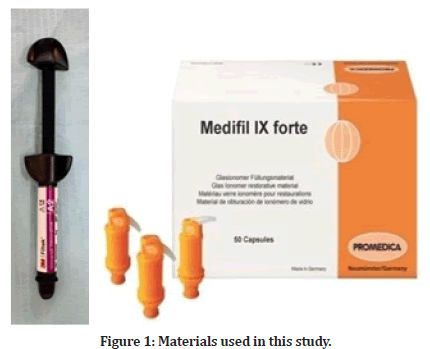
Figure 1: Materials used in this study.
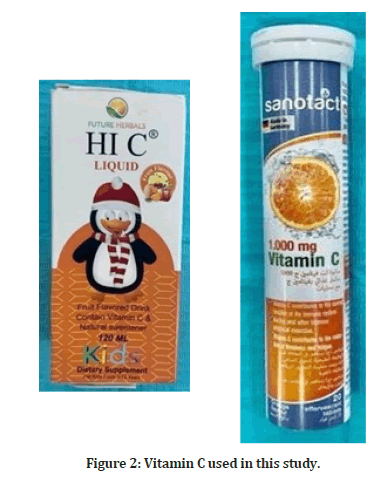
Figure 2: Vitamin C used in this study.
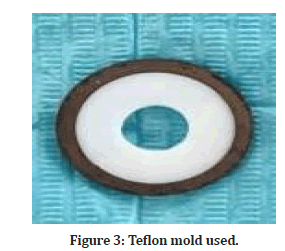
Figure 3: Teflon mold used.
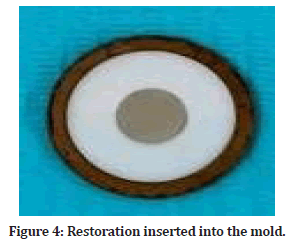
Figure 4: Restoration inserted into the mold.
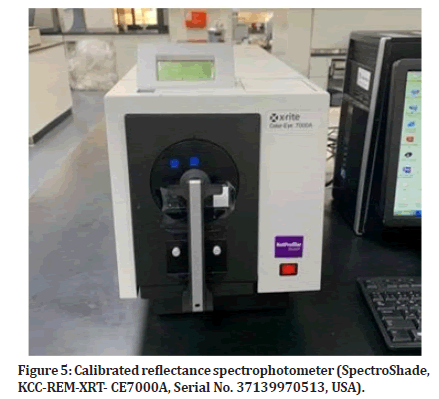
Figure 5: Calibrated reflectance spectrophotometer (SpectroShade, KCC-REM-XRT- CE7000A, Serial No. 37139970513, USA).
Preparation of specimens
A total of 90 disc-shaped round specimens (10mmx2mm), 45 samples from each restorative material, were prepared as described on each of the material’s manuals for the color stability test. Each substance was manipulated between two opposing glass labs in a Teflon mold as shown in figures 6 and 7. The Resin Modified glass ionomer cement (Medifil IX forte LC, Promedica Dental Material GmbH, Application capsule, Germany) was light cured using a Led curing light (E-Morlit, APOZA, Taiwan) with a light intensity of 1600 mW/cm2, according to the manufacturer’s instructions as shown in Figure 8 with zero distance then allowed to set for 10 minutes at room temperature. The Composite (3M, One Bulk Fill, Germany) and RMGI (Medifil IX forte LC, Promedica Dental Material GmbH, Application capsule, Germany) materials were polymerized through the glass slide using a Led curing light (E-Morlit, APOZA, Taiwan) with a light intensity of 1600 mW/cm2, according to the manufacturer’s instructions with zero distains. Following the removal of the specimens from the Teflon mold with split that helping in glass slide removal as shown in Figure 9, after completed polymerizations, the specimens were kept in dark incubator at room temperature for 24 h to prevent color change. Initial color stability values were measured and recorded at baseline before and after immersion on the 28th days.
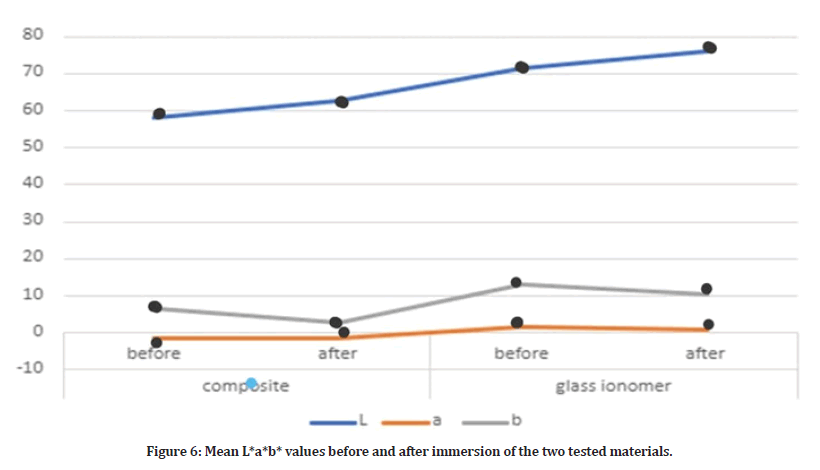
Figure 6: Mean L*a*b* values before and after immersion of the two tested materials.
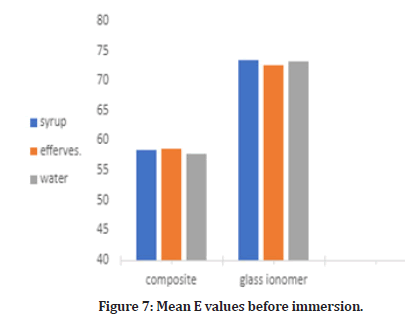
Figure 7: Mean E values before immersion.
Immersion cycles
The specimens of each restorative materials were randomly divided into three subgroups according to the immersion medium of vitamin C syrup (HIC Stars (FUTURE HERBALS, Nutra-C,USA), vitamin C effervescent Sanotact (Sanotact, germany) and distilled water as (a control group) (Al Hasana Factory integrated, Jeddah, SA). The immersion cycling protocol used in this study was adopted in order to simulate actual consumption of the Vitamin C. Over a period of 28 days, the specimens were immersed in either 20 ml distilled water with 1 effervescent tablet or in 10 ml of the Vitamin C syrup for 2 min a day with 24h intervals between the immersion cycles. The specimens were rinsed and stored in distilled water after each immersion cycle until the next one. The syrup/effervescent were refreshed before each immersion. During the whole experiment (28 days), the control specimens were kept in distilled water, which was refilled daily. Color stability was measured on the 28th days for each disc-shaped specimen.
Color stability tests
The initial color of each specimen was measured before immersed by a calibrated reflectance spectrophotometer (SpectroShade, KCC-REM-XRT- CE7000A, Serial No. 37139970513, USA). These measurements were performed with a black background as shown in Figure 5.
Color change (DE) mathematically expresses the amount of difference between the Commission Internationale de I’Eclairage (CIE) L*a*b* coordinates of different specimens or the same specimen at different instances. The L* value is a measure of the lightness, the * value is a measure of redness (positive a*) or greenness (negative a*) and the b* value is the measure of an object's yellowness (positive b*) or blueness (negative b*). The CIELAB color difference formula is intended to provide numeric data (E) expressing the amount of the color difference between two objects.
Statistical analysis
E value Data for tested group before immersion (0 day) and after immersion ( 28 days ) and delta E value of all tested supgroups were obtained then entered into MS Excel spreadsheet. Descriptive statistics was calculated for each variable for the six subgroups. The values of color change delta E were compared using one‐way Kruskak Wallis test followed by delta E comparison by Mann Whitney U test.
Results
The test of normality indicates that data is mostly nonparametric or non-normally distributed. As shown in Table 1 and illustrated in Figure 6, mean *L values have increased In composite and glass ionomer after immersion and as p values were: (0.002),(0.001) respectively. While mean *a values remain the same in composite p=0.851 and reduced in glass ionomer: P=0.001. lastly, mean *b values decreased in both materials, unlike the *L values. All *L-*a-*b values in the two tested materials were significant different before and after immersion ( p value <0.05) except *a values in composite (p value=0.851).
| mean ± SD median (range) | before | after | p-value | |
|---|---|---|---|---|
| Composite | L | 58.0 ± 1.1 | 62.7 ± 3.6 | 0.002 |
| 57.9 (56.7 – 60.7) | 63.3 (56.9 – 68.3) | |||
| a | -1.3 ±0.1 | -1.3 ± 0.2 | 0.851 | |
| -1.3 (-1.6 - -1.1) | -1.4 (-1.7 - -0.9) | |||
| b | 6.4 ± 0.5 | 2.9 ± 2.8 | 0.001 | |
| 6.3 (5.8 – 7.3) | 3.1 (-2.1 – 6.5) | |||
| RMGI | L | 71.5 ± 2.6 | 76.0 ± 1.4 | 0.001 |
| 71.9 (63.2 – 74.2) | 75.7 (73.9 – 79.3) | |||
| a | 1.6 ± 0.5 | 0.7 ± 0.5 | 0.001 | |
| 1.8 (-0.02 – 2.0) | 0.8 (-0.8 – 1.1) | |||
| b | 12.9 ± 2.5 | 10.2 ± 1.5 | 0.001 | |
| 13.7 (4.3 – 13.9) | 10.36 (6.0 – 12.1) | |||
Table 1: Mean L*a*b* values of composite and glass ionomer.
Figures 7 and Figure 8 represent the mean E values of the samples for baseline and after immersion respectively, which displayed difference between the groups before and after immersion especially in composite.
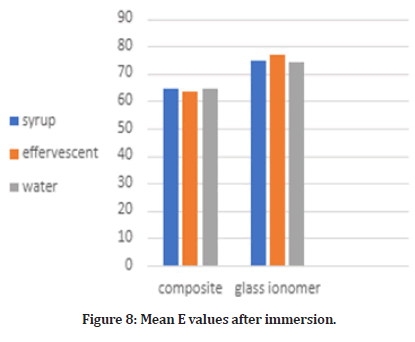
Figure 8:Mean E values after immersion.
Table 2 shows the effect of the immersion solutions on the two tested restorative materials. There was a significant difference in the change of composite color when immersed in the three different solutions (p=0.010). Composite showed significantly less change in color when immersed in effervescent (4.8 ± 1.5) compared to water (6.7 ± 1.5). There was also a significant difference of color change of RMGI when immersed in the different solutions (p<0.001). RMGI immersed in effervescent showed significantly higher mean change in color (4.0 ± 2.6) compared to the mean change in color of RMGI when immersed in syrup (1.1 ± 2.5) or water (0.9 ± 1.1).
| mean ± SD median (range) | Syrup | Effervescent | Water | p-value |
|---|---|---|---|---|
| composite | 6.2 ± 2.2 | 4.8 ± 1.5 | 6.7 ± 1.5 | 0.01 |
| 6.3 (1.9 - 10.3) | 5.3 (1.2 - 6.8) | 7.3 (3.9 - 8.3) | ||
| ab | a | b | ||
| RMGI | 1.1 ± 2.5 | 4.0 ± 2.6 | 0.9 ± 1.1 | <0.001 |
| 1.9 (-6.0 - 3.6) | 3.2 (1.2 - 12.0) | 0.8 (-1.1 - 2.4) | ||
| a | b | a |
Table 2: Comparison of ΔE among the different restorative materials.
Regarding the comparison of the two different materials when immersed in each of the three different solutions. Composite restorations showed significantly higher means of delta E compared to RMGI when immersed in syrup (p<0.001), effervescent (p=0.045), or water (p<0.001). as shown in Table 3 and illustrated in Figure 9 which displayed the average and standard deviation of delta E which reflects the net difference between the two circumstances: before and after immersion.
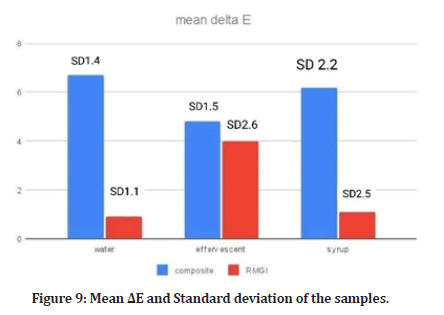
Figure 9:Mean ΔE and Standard deviation of the samples.
| Mean ± SD median (range) | Composite | RMGI | p-value |
|---|---|---|---|
| Syrup | 6.2 ± 2.2 | 1.1 ± 2.5 | <0.001 |
| 6.3 (1.9 - 10.3) | 1.9 (-6.0 - 3.6) | ||
| Effervescent | 4.8 ± 1.5 | 4.0 ± 2.6 | 0.045 |
| 5.3 (1.2 - 6.8) | 3.2 (1.2 - 12.0) | ||
| water | 6.7 ± 1.5 | 0.9 ± 1.1 | <0.001 |
| 7.3 (3.9 - 8.3) | 0.8 (-1.1 - 2.4) | ||
| Note: Mann Whitney U test. | |||
Table 3: Comparison of delta E among the different solutions.
Discussion
The use of vitamin C has been increased dramatically by individuals during the last two years due to the emerge of covid-19 and people started taking the vitamin C over the counter as it supports the immune system [1].
Composite and resin-modified glass ionomer are resinbased restorations widely used in the restorative dentistry, since they are tooth-colored esthetic restoration which implement the patients satisfactions. These restorations are of a big interest between patients and dentists and widely known and accepted. Longevity and success rates are considered the parameters of a great importance needed to be fulfilled for such restorations.
Bulk-Fill composite has been produced in the market to help dentists deal better with uncooperative patient, because it can be inserted effectively in the cavity with fewer increments up to 4 mm thick, thus reducing working time [21].
There is no previous trial has used BULK fill resin composite which is more popular recently in the dental market when using vitamin C solely as an exposure medium in the experiment. On the other hand, the study that evaluated the effect of acidic solutions on the composite restorations, did not use the vitamin C as a pure exposure variable [13]. Therefore, the lack of studies on the effect of different forms of vitamin C specifically on the color characteristics of composite resin restoration lead us to our research.
Moreover, some investigators used different tools other than spectrophotometer for color change testing ; Afzali, et al. [14] used digital camera and then adobe photoshop software program for editing after digital imaging of the samples, and used the CIE L*a*b* system for color evaluation. Nevertheless, using spectrophotometer is considered a shorter alternative approach for such a measurement. Spectrophotometer is considered easier, most accurate, and the best reliable technique for color analysis as Ferreira, et al. [23] recommended when compared between two different devices (digital camera and spectrophotometry) during color assessment of the Giomer resin composite (Beautifil-Bulk) [23]. It is advanced and applicable technology that aids in reduction of working time specially when measuring large-sized samples and can analyze the difference that is not detectable by naked eye.
The measurements of color differences in our trial were done using CIELab color system. This system depends on human’s visual perception. The values obtained [ΔEs] are categorized into 3 components as explained by Marianna, et al. [21]: if its < 1 means color change is not detectable by human’s eye; ΔE between 1 and 3.3 is read as clinically acceptable ; and ΔE > 3.3 is clinically not acceptable.
This system determines the color in terms of three values : L,a b. L* determines the lightness, a* determines redness (+a) or greenness (- a), and b determines yellowness (+b) or blueness (-b) [22]. Giving our results ; lightness increased in composite and glass ionomer. While composite remain greenness before and after trial ( -ve values), and finally both materials with their yellowness perspectives showed reduction after immersion.
According to our study, It was obvious that restoration immersion in vitamin C have an impact on the color stability of the two tested materials. Immersion in vitamin C in the form of either effervescent or syrup for 28 days was the technique used in our experiment as it simulated the actual time of consumption by patient (for 2 minutes daily), distilled water was used as a control solution to mimic the wet oral environment as it is considered purified water containing less ions and impurities [17]. In this study composite resin showed more color change than resin modified glass ionomer. In addition, the experiment revealed that the control groups immersed in water also got affected, and this can be explained by the osmotic pressure and the solubility of the material, this finding was in accordance with Tanthanuch, et al. [20]; He explained the role of water absorption in changing the physical properties of resinbased restorative materials ; as water enters the silane interface that couples the fillers with the resin monomers, it will makes it break down and consequently ; will cause the material to be degraded. Therefore, this can be the reason why the control groups that remain and stored 28 days in the distilled water have been altered and their colors properties changed after the immersion.
Additionally, Bulk fill - FILTEK composite composed of higher content of organic matrix of resin monomers might lead to lower resistance to water degradation, being more liable to water absorption as well as lower polymer conversion as explained by Marianna, et al. [21], and this can justify and interpret why mean ΔE of all composite groups were more affected than glass ionomer in our results.
On the other hand, the composite resin group showed more color change in the yellow colored syrup medium than the effervescent tablets which may be due to the adsorption and absorption of the yellow colorants of different polarity onto the surface of resin composite material [24].
The effervescent form has the worse negative effect on resin modified glass ionomer compared to syrup due to its lower PH and the presence of bicarbonate and high amount of sodium and/or potassium [17]. In the present study, the effervescent group in resin modified glass ionomer restoration displayed the worse effect and this result was in agreement with Guler, et al. [17], as the author evaluated the impact and effect of multivitamins syrups and effervescent tablets on the restorative materials surfaces, they found out that both control group and comparison groups were having a noticeable decrease in their microhardness values from the beginning of the experiment till the end. The effervescent form has the worse negative effect on the tested materials in both roughness and microhardness compared to syrup vitamins.
In addition, the immersion in acidic media predispose the resin modified glass ionomer material to greater ion release due to greater amount of ionic changes between the glass ionomer and the acidic medium [25,26].
Many researchers assessed and evaluated the quality of different features of the restorations like microhardness and surface roughness which in turn has a great relation to color stability [8,14,16-18].
Based on the results of this study, the usage of vitamin C syrups and effervescent pills for 28 days may have a negative impact on the color stability of composite Bulk-fill filtek and Medifil resin modified glass ionomer restorative materials.
Recommendation
Patient selections for these resin restorations; cooperation and compliance are of a great importance. Regular check-up with the dentist for existing restoration should be in mind, and preventive measures such as rinsing mouth with water after ingestion of vitamin C is also advisable to counteract the risk. Further trial has to be done in vivo to support our findings.
Acknowledgement
The authors of this research would like to thank the Research Centre At Faculty of Dentistry in king Abulaziz University (KAUFD), the lab technicians, and Dr Osama felemban who helped with statistical work
References
- Lykkesfeldt J, Michels AJ, Frei B. Vitamin C. J Adv Nutr 2014; 16-18.
- Granger M, Eck P. Dietary vitamin C in human health. Adv Food Nutr Res 2018; 83:281-310.
- Hemilä H, Chalker E. Vitamin C for preventing and treating the common cold. Cochrane Database Syst Rev 2013.
- Abobaker A, Alzwi A, Alraied AH. Overview of the possible role of vitamin C in management of COVID-19. Pharmacol Rep 2020; 72:1517-15228.
- Carr AC, Rowe S. The emerging role of vitamin C in the prevention and treatment of COVID-19. Nutrients 2020; 12:3286.
- Knight J, Madduma-Liyanage K, Mobley JA, et al. Ascorbic acid intake and oxalate synthesis. Urolithiasis 2016; 44:289-297.
- Mistry P, Batchelor H. Evidence of acceptability of oral paediatric medicines: A review. J Pharm Pharmacol 2017; 69:361-376.
- Mali GV, Dodamani AS, Karibasappa GN, et al. Effect of conventional and sugar free pediatric syrup formulations on primary tooth enamel hardness: An in vitro study. J Indian Soc Pedod Prev Dent 2015; 33:331.
- Arora R, Mukherjee U, Arora V. Erosive potential of sugar free and sugar containing pediatric medicines given regularly and long term to children. Indian J Pediatr 2012; 79:759-763.
- Stahl H. Effervescent dosage manufacturing. J Pharm Technol 2003; 25-28.
- Wegehaupt FJ, Lunghi N, Hogger VM, et al. Erosive potential of vitamin and vitamin+ mineral effervescent tablets. Swiss Dent J 2016; 126:457-465.
- Lussi A, Megert B, Shellis RP, et al. Analysis of the erosive effect of different dietary substances and medications. Br J Nutr 2012; 107:252-262.
- Münchow EA, Ferreira AC, Machado RM, et al. Effect of acidic solutions on the surface degradation of a micro-hybrid composite resin. Braz Dent J 2014; 25:321-326.
- Afzali BM, Ghasemi A, Mirani A, et al. Effect of ingested liquids on color change of composite resins. J Dent 2015; 12:577.
- Scatena C, Galafassi D, Gomes-Silva JM, et al. In vitro erosive effect of pediatric medicines on deciduous tooth enamel. Braz Dent J 2014; 25:22-27.
- Pasdar N, Alaghehmand H, Mottaghi F, et al. Experimental study of iron and multivitamin drops on enamel microhardness of primary tooth. J Int Soc Prev Community Dent 2015; 5:518.
- Guler EB, Bayrak GD, Unsal M, et al. Effect of pediatric multivitamin syrups and effervescent tablets on the surface microhardness and roughness of restorative materials: An in vitro study. J Dent Sci 2021; 16:311-317.
- Bitencourt SB, Catanoze IA, da Silva EV, et al. Effect of acidic beverages on surface roughness and color stability of artificial teeth and acrylic resin. J Adv Prosthod 2020; 12:55.
- Scatena C, Galafassi D, Gomes-Silva JM, et al. In vitro erosive effect of pediatric medicines on deciduous tooth enamel. Braz Dent J 2014; 25:22-27.
- Tanthanuch S, Kukiattrakoon B, Eiam‐O‐Pas K, et al. Surface changes of various bulk‐fill resin‐based composites after exposure to different food‐simulating liquid and beverages. J Esthet Restor Dent 2018; 30:126-135.
- Silva MF, Dias MF, Lins-Filho PC, et al. Color stability of Bulk-Fill composite restorations. J Clin Exp Dent 2020; 12:e1086.
- Jain C, Bhargava A, Gupta S, et al. Spectrophotometric evaluation of the color changes of different feldspathic porcelains after exposure to commonly consumed beverages. Eur J Dent 2013; 7:172-180.
- Ferreira LD, da Cunha Peixoto RT, de Magalhães CS, et al. Comparison of instrumental methods for color change assessment of Giomer resins. Restor Dent Endod 2022; 47.
- Bagheri R, Burrow MF, Tyas M. Influence of food-simulating solutions and surface finish on susceptibility to staining of aesthetic restorative materials. J Dent 2005; 33:389-398.
- Ren YF, Feng L, Serban D, et al. Effects of common beverage colorants on color stability of dental composite resins: The utility of a thermocycling stain challenge model in vitro. J Dent 2012; 40:e48-56.
- Hotwani K, Thosar N, Baliga S. Comparative in vitro assessment of color stability of hybrid esthetic restorative materials against various children's beverages. J Conserv Dent 2014; 17:70.
Indexed at, Google Scholar, Cross Ref
Indexed at, Google Scholar, Cross Ref
Indexed at, Google Scholar, Cross Ref
Indexed at, Google Scholar, Cross Ref
Indexed at, Google Scholar, Cross Ref
Indexed at, Google Scholar, Cross Ref
Indexed at, Google Scholar, Cross Ref
Indexed at, Google Scholar, Cross Ref
Indexed at, Google Scholar, Cross Ref
Indexed at, Google Scholar, Cross Ref
Indexed at, Google Scholar, Cross Ref
Indexed at, Google Scholar, Cross Ref
Indexed at, Google Scholar, Cross Ref
Indexed at, Google Scholar, Cross Ref
Indexed at, Google Scholar, Cross Ref
Indexed at, Google Scholar, Cross Ref
Indexed at, Google Scholar, Cross Ref
Indexed at, Google Scholar, Cross Ref
Indexed at, Google Scholar, Cross Ref
Indexed at, Google Scholar, Cross Ref
Indexed at, Google Scholar, Cross Ref
Indexed at, Google Scholar, Cross Ref
Author Info
Abdulaziz Zahid*, Ayman Alkaabi, Hanan K Abouelseoud and Dalia Abuelmagd
Department of Restorative Dentistry, Faculty of Dentistry, King Abdulaziz University, Jeddah, KSAReceived: 26-Dec-2022, Manuscript No. jrmds-22-84666; , Pre QC No. jrmds-22-84666(PQ); Editor assigned: 27-Dec-2022, Pre QC No. jrmds-22-84666(PQ); Reviewed: 10-Jan-2023, QC No. jrmds-22-84666(Q); Revised: 16-Jan-2023, Manuscript No. jrmds-22-84666(R); Published: 23-Jan-2023
